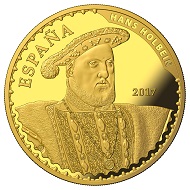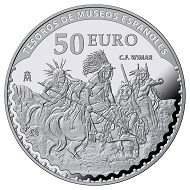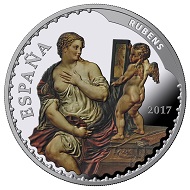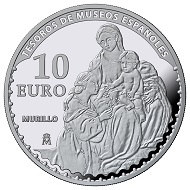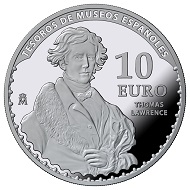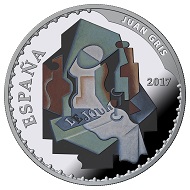July 27, 2017 – 2017 marks the 25th Anniversary of the Thyssen-Bornemisza Museum. Part of the “Golden Triangle of Art” in Madrid, which also includes the Prado and the Reina Sofia national galleries, the Thyssen fills the historical gaps in its counterparts’ collections. Replicating some of the most famous paintings displayed in this museum, the Royal Spanish Mint (Real Casa de la Moneda) releases the fifth part of the series “Treasures of Spanish Museums”.
Spain / 400 Euros / Gold .999 / 27g / 38mm / Mintage: 2000.
400 Euro Gold Coin – Holbein the Younger & Ghirlandaio
Hans Holbein, the Younger, “Portrait of Henry VIII of England” (ca. 1537): This likeness of the famous Tudor king is a magnificent example of Holbein’s remarkable style, characterised by a monumental rendering of figures which are nonetheless endowed with considerable psychological depth. In this markedly linear portrait, Holbein uses the frontal pose of the regal model and the position of his hands to convey the sitter’s powerful personality and majestic bearing.
Domenico Ghirlandaio, “Portrait of Giovanna Tornabuoni” (1489-90): This superb panel is a fine example of fifteenth-century Florentine portraiture. Artists of the time followed classical dictates: body proportions were idealised while faces left devoid of expression were expected to convey character. In this half-length portrait, the sitter appears in strict profile, with her arms bent and her hands clasped together. In the background, a selection of personal belongings appears within a simple architectural frame.
Spain / 50 Euros / Silver .925 / 168.75g / 73mm / Mintage: 3000.
50 Euro Silver Coin – Hopper & Wimar
Edward Hopper, “Hotel Room” (1931): The loneliness of the modern city is a central theme in Hopper’s work. In this painting, a woman sits on the edge of a bed in an anonymous hotel room. It is night and she is tired. The space is confined by the wall in the foreground and the chest of drawers on the right; while the long diagonal line of the bed directs our gaze to the background, where an open window turns the viewer into a voyeur on what is happening in the room.
Charles Ferdinand Wimar, “The Lost Trail” (ca. 1856): Wimar depicts the Indians as exiles, roaming a land that is no longer theirs. Their appearance, with naked torsos and painted faces, reflects the stereotypes established by his contemporaries and European romantic fantasies about the free and adventurous life at the American border.
The artist uses in this canvas a very powerful painterly language and a highly studied composition.
Spain / 10 Euros / Silver .925 / 27g / 40mm / Mintage: 7500.
10 Euro Silver Coin – Rubens & Murillo
Peter Paul Rubens, “Venus and Cupid” (ca. 1606-1611): Rubens was the most outstanding of all Flemish painters and a leading exponent of Baroque art. His influence on 17th century painting was enormous, due to his personal fame, but also to the prints which he made after his own compositions.
“Venus and Cupid” is one of his copies of an original by Titian -now lost- which belonged to the Spanish royal collections. The Flemish painter’s subtlety of execution and superb mastery of colour are the most distinctive features of his style.
Bartolomé Esteban Murillo, “The Virgin and Child with Saint Rose of Viterbo” (ca. 1670): This canvas belongs to Murillo’s mature period. Its large size suggests that it was painted for an altar. It uses a classical, triangular composition of a harmonious type to depict the figures on a large scale in the foreground. The loose brushstrokes that sketchily define the forms and the emotional mood created by the gazes, gestures and poses of the principal group, make this canvas a fine example of Murillo’s work with its characteristic softness and delicacy that was so highly appreciated.
Spain / 10 Euros / Silver .925 / 27g / 40mm / Mintage: 7500.
10 Euro Silver Coin – Manet & Lawrence
Édouard Manet, “Horsewoman, Fullface” (ca. 1882): A practitioner of realism, Édouard Manet was a pivotal figure in the renewal of French and Western painting of the late nineteenth century.
“Horsewoman, Fullface” belongs to an unfinished series on the four seasons that Édouard Manet painted in the last two years of his life. The fact that the work is unfinished clearly shows how confidently it is executed, without hesitation, and the skill with which Manet succeeded in capturing and conveying the essential.
Thomas Lawrence, “Portrait of David Lyon” (ca. 1825): Thomas Lawrence was the greatest English portraitist of the 19th century and an artist whose work forms a connecting link between 18th century trends, which he absorbed and applied, and the new aesthetic of the 19th century.
“Portrait of David Lyon” is a mature work. Lawrence locates his sitter in a spacious, tranquil landscape setting, imbuing the image with a characteristic air of distinction and elegance conveyed through the young man’s clothing and pose.
Spain / 10 Euros / Silver .925 / 27g / 40mm / Mintage: 7500.
10 Euro Silver Coin – Gris & Degas
Juan Gris, “Bottle and Fruit Dish” (1919): Spanish painter and sculptor, Juan Gris is hailed as a major exponent in cubism. His importance lay both in his works, chiefly portraits and still-life scenes, and in his theoretical contribution.
“Bottle and Fruit Dish” exhibits an interplay of warm brown tones combined with colder greens and greys, taken directly from the landscape. The arrangement of the napkin that hangs over the edge of the table has an interesting significance in the context of the so-called post-war “return to order” of the avant-garde.
Edgar Degas, “Swaying Dancer” (1877-79): Despite his connections with the group of Impressionists, with whom he exhibited in seven of their eight shows, Degas was to an extent an anti-Impressionist. Nevertheless, Degas shared the Impressionists’ special interest in the reality of city life, and the opera, theatre, café-concert and horse races were constant themes in his work.
“In Swaying Dancer”, the group of dancers is depicted in mid-performance, as viewed from an upper side box. The fleeting nature of the movements is captured with rapid pastel strokes, applied with immense skill.
For more information on these and other releases please visit the Spanish Mint’s website.
And this is the Museum Thyssen-Bornemisza webpage.





